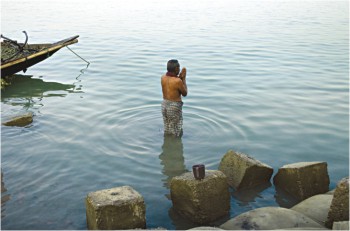Living with Erosion
With COP 16 over, that has set the agreement on creating the Green Climate Fund for the poorest and worst-affected countries of climate change, there is hope that Bangladesh may just pull its funds and population of climate refugees out before it's too late. Erosion is by far one of the main causes for thousands of people becoming helpless victims to Climate Change. The time is now for the government to act fast and reinvest in main districts like Chandpur in order to fight against one of the most vital global issues of the 21st Century.
Photos and text by Jo Straube
 Bangladesh has always been called The land of the rivers, and it is not without reason. The mighty rivers such as Brahmaputra, Padma and Meghna is eating thousands of hectors land every year; making thousands of people go homeless. About 100,000 families lose their homes annually. Bangladesh has always been called The land of the rivers, and it is not without reason. The mighty rivers such as Brahmaputra, Padma and Meghna is eating thousands of hectors land every year; making thousands of people go homeless. About 100,000 families lose their homes annually.
The soil is rich, and important for agriculture. But Bangladesh not only loses agricultural land and homes, but with it several kilometres of roads, railways and flood embankments are taken away too -- creating a further financially challenging stipulation for the country.
Several cities have also been threatened by river erosion, one of them being Chandpur. With its roughly 300,000 citizens, Chandpur is the most important port in the Comilla district. The city is extremely vulnerable to river erosion because it sits exactly where Rivers Padma and Jamuna meet the great Meghna River.

In 2001 almost 50 percent of the city centre had been eroded, and the river had eaten its way to the main bazaar, ferry terminal and railway station. In only one hour on September 19, 2001, the hub of the trading zone disappeared into the river.
After 2001 the city is no longer dramatically threatened. The city has rebuilt an artificial peninsula where the old trade centre was, and it is now used as a park. There is still some erosion near the city centre, but with embankments on the whole river shore the river only destroys the most vulnerable areas, where 20 to 30 crore taka is used every year to repair the temporary embankments. Getting that money has become a vital problem.
The rising sea level will force internal migration and what will happen in this densely populated area within Chandpur is not clear. Most will argue that there is no other option than to find solutions to continue living with this state of climatic calamities.

The future of Bangladesh will be in the hands of international organizations and the upstream countries such as China and India. Dams built in the upstream countries can help control the annual floods. But they have to be corporative. The Farakkah Barrage completed in 1975 has caused many debates about how it cuts off Bangladesh's water supply. And if China decides to realise their plans to divide Brahmaputra and lead one course into the Gobi desert, that could lead to major desertification and change of livelihood in Bangladesh.
Even though Bangladesh seems to be drowning, it needs the water to produce the vital 300 million tons of food the country is producing annually.
Copyright
(R) thedailystar.net 2010 |
